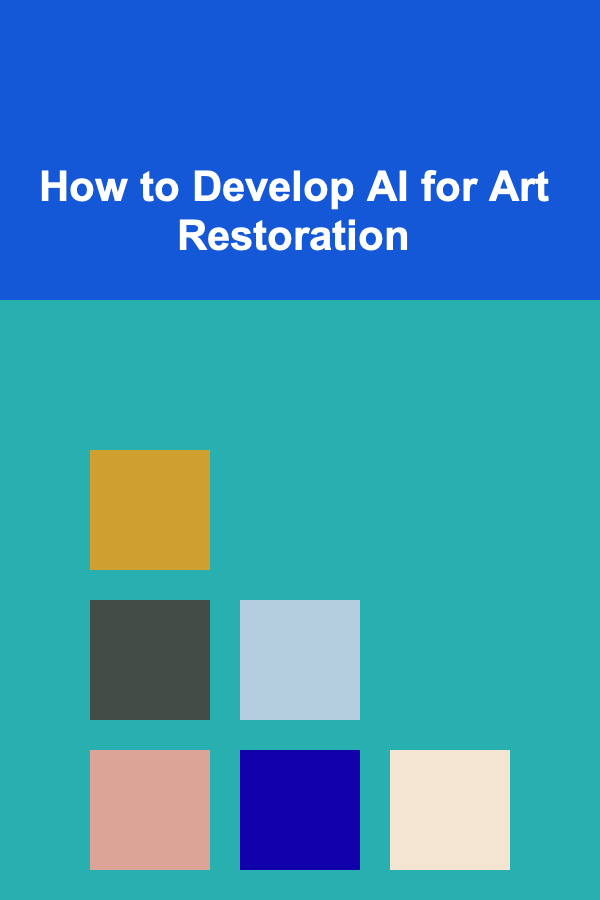
How to Develop AI for Art Restoration
ebook include PDF & Audio bundle (Micro Guide)
$12.99$8.99
Limited Time Offer! Order within the next:

Art restoration is a process of repairing, preserving, and conserving artworks to return them to their original or near-original state. This intricate process involves delicate care, a profound understanding of art history, chemistry, and techniques specific to each medium. In recent years, advancements in artificial intelligence (AI) have begun to play a significant role in art restoration. AI technologies have shown promise in offering tools that can accelerate restoration processes, enhance precision, and even help in creating techniques that were previously unimaginable. But how can we develop AI for art restoration? In this article, we will explore the development of AI in this field, the challenges, the technologies involved, and how AI can be implemented to restore valuable artwork for future generations.
The Role of Art Restoration in Cultural Heritage
Artworks are not just pieces of decoration; they are critical pieces of history. They reflect the culture, values, and knowledge of their creators and their time. As time passes, however, many artworks begin to degrade, often due to exposure to environmental conditions, the passage of time, and wear and tear caused by improper handling. In some cases, natural disasters or accidents may severely damage artworks, making restoration an essential process in saving these cultural treasures.
Traditional restoration methods have largely been manual and meticulous, involving conservators who use their skills to analyze, clean, and repair damaged artworks. While this process can produce great results, it is also time-consuming, expensive, and subject to human error. Moreover, not all damages are visible to the naked eye, requiring specialized equipment or methodologies to ensure that the restoration is as true to the original as possible.
AI, however, introduces a new frontier for art restoration, offering potential solutions that could address the limitations of traditional restoration techniques. With the growing field of computer vision, machine learning, and deep learning algorithms, AI can assist conservators in numerous ways to ensure that artwork is restored to its true form.
How AI Can Contribute to Art Restoration
The integration of AI into art restoration aims to provide more accurate, faster, and cost-effective methods. The applications of AI span various areas of the restoration process, from analyzing the condition of the artwork to providing insights into the most effective restoration techniques.
1. Analyzing Artworks and Identifying Damage
One of the first challenges in art restoration is determining the extent of damage to an artwork. While some damage is visible, other forms of degradation may not be immediately apparent. This could include issues like fading pigments, cracks beneath the surface, or underlying mold growth.
AI-driven image recognition and analysis can help detect both visible and hidden damage in artworks. Using high-resolution imaging techniques such as infrared and X-ray scans, AI can identify inconsistencies in materials, layers, and pigments that are not visible to the naked eye. For instance, infrared imaging helps to reveal sketches or underdrawings beneath the surface layers of paint, providing conservators with valuable insights into an artist's creative process.
Additionally, machine learning models can be trained to recognize patterns and anomalies in artworks. By feeding these algorithms large datasets of historical artworks and restoration records, AI systems can become increasingly adept at identifying signs of damage, wear, and degradation.
2. Restoring Missing or Damaged Parts of Artwork
Restoring missing or damaged portions of an artwork is one of the most delicate tasks in art restoration. Whether it's a missing section of a fresco, a cracked canvas, or a chipped sculpture, the aim is to replicate the original work as closely as possible.
AI can help by using image synthesis techniques to recreate missing sections of art. Generative Adversarial Networks (GANs), a class of deep learning models, are particularly useful in this context. GANs work by generating new images based on patterns learned from a dataset of similar artworks. In the context of art restoration, GANs can generate missing or damaged portions of an artwork that are consistent with the original, maintaining the artist's style, color palette, and texture.
These AI-driven restorations can significantly reduce the time required for manual restoration while ensuring a more accurate reconstruction of the original piece. Moreover, AI models can also assist in determining the most effective materials and techniques for the restoration of these sections, based on the artwork's age, composition, and the surrounding environmental conditions.
3. Identifying the Artist's Style and Technique
Understanding the artist's unique style and technique is crucial in art restoration. Restoration efforts should reflect the artist's vision, ensuring that the work's integrity is maintained while repairing damage. However, many artworks have been altered by time, environmental factors, and previous restoration attempts, making it difficult to decipher the original technique used by the artist.
AI can play an essential role in identifying the artist's style and technique. Through machine learning, AI models can analyze an artist's body of work, identifying specific patterns in brush strokes, color choices, and even the texture of materials used. By examining large datasets of artworks, AI systems can pinpoint features unique to a particular artist or art movement.
For instance, AI can help identify specific brushstroke techniques by analyzing the texture and directionality of the strokes. This information can then be used to guide restoration efforts, ensuring that any repairs or additions are consistent with the artist's original methods.
4. Enhancing Restoration Processes with AI-Assisted Tools
AI-powered tools can be integrated into various stages of the restoration process, from scanning and analysis to the actual physical restoration work. These tools can automate tasks, reduce the need for manual labor, and improve precision. For example, 3D printing technology, powered by AI, can be used to create replicas of damaged sculptures or architectural features, allowing conservators to restore these objects without risking further harm to the original piece.
AI tools can also help conservators analyze the chemical composition of pigments, paints, and other materials used in the artwork. This data can be valuable in understanding how the artwork has aged and in determining which restoration techniques will be most effective. For instance, AI can help analyze the degradation of pigments and recommend optimal approaches to reapplying or stabilizing the paint layers.
5. Preserving Artwork for the Future with Predictive Models
Another promising application of AI in art restoration is the ability to predict future degradation. By using AI to analyze current damage patterns and environmental conditions, machine learning models can predict how the artwork may deteriorate over time. This predictive analysis can inform conservation efforts, helping conservators take preventative measures to reduce future damage.
For example, predictive models can consider variables such as temperature, humidity, and light exposure, which are known to affect the preservation of artwork. Based on this data, AI can recommend specific actions, such as adjusting the environmental conditions or employing particular materials to prevent further damage.
Predictive models can also help monitor artworks over time, alerting conservators to any changes or signs of degradation that may require intervention. This type of AI-driven monitoring could be especially beneficial in large galleries or museums where artworks are frequently on display.
The Challenges in Developing AI for Art Restoration
While the potential for AI in art restoration is immense, there are several challenges to overcome. These challenges range from technical limitations to ethical concerns, and each must be addressed carefully to ensure AI is used responsibly and effectively in this sensitive field.
1. Quality of Data and Training Models
AI algorithms rely heavily on data for training and refinement. To develop an AI system capable of effectively restoring artwork, a large, high-quality dataset of artworks, restoration techniques, and damage types is necessary. However, obtaining such data is challenging, as many artworks are unique, and detailed records of restoration efforts may not be available.
Moreover, training AI systems requires vast computational resources and expert input from art historians, conservators, and other specialists. The accuracy and effectiveness of the AI system depend on the quality of the training data, which means that AI systems must be trained on diverse and representative examples of artworks from various periods, artists, and styles.
2. Preserving the Artist's Intent
One of the biggest concerns with using AI for art restoration is the possibility of altering or distorting the artist's original intent. While AI can generate missing portions of artwork or suggest restoration techniques, it cannot fully comprehend the artistic, historical, or cultural significance of the work.
The challenge is to ensure that AI tools are used as aids rather than replacements for human expertise. AI can suggest solutions, but the final decisions should always be made by experienced conservators who can consider the historical context and the artist's original intent.
3. Ethical Considerations
AI-driven restorations raise ethical concerns about authenticity and the limits of intervention. How far can AI go in recreating or repairing a work of art before it is no longer considered the original? At what point does restoration cross the line into reconstruction, and can AI-driven restorations truly preserve the cultural significance of a piece?
Furthermore, there is the issue of ownership and intellectual property. AI-generated restorations may blur the lines between the artist's original work and the restoration, raising questions about authorship and copyright. As AI technologies evolve, new ethical frameworks will be needed to guide their use in art restoration.
The Future of AI in Art Restoration
Despite the challenges, the future of AI in art restoration holds significant promise. As AI technologies continue to advance, the possibilities for their integration into the restoration process will only grow. In the coming years, we may see AI playing an even larger role in conserving the world's cultural heritage, helping us preserve the masterpieces of the past for future generations.
AI can also encourage new forms of collaboration between art experts, conservators, and technologists. With the growing convergence of art, science, and technology, AI can help us not only restore artwork but also gain new insights into the history and creative processes behind the masterpieces.
In conclusion, developing AI for art restoration is an exciting and evolving field. By harnessing the power of AI, we can improve the speed, accuracy, and precision of restoration work while preserving the integrity of cultural treasures for generations to come. As with any technology, its development must be handled thoughtfully, ethically, and in collaboration with art experts to ensure that AI serves to enhance, rather than diminish, our appreciation of art and culture.

How to Create a Milestone Photo Album for Kids
Read More
How to Read Your Pet's Body Language
Read More
How to Understand and Compare Investment Options
Read More
How to Use Color-Coded Folders for Document Organization
Read More
How to Save for a Big Purchase
Read More
How to Build a Crisis-Resistant Portfolio
Read MoreOther Products

How to Create a Milestone Photo Album for Kids
Read More
How to Read Your Pet's Body Language
Read More
How to Understand and Compare Investment Options
Read More
How to Use Color-Coded Folders for Document Organization
Read More
How to Save for a Big Purchase
Read More